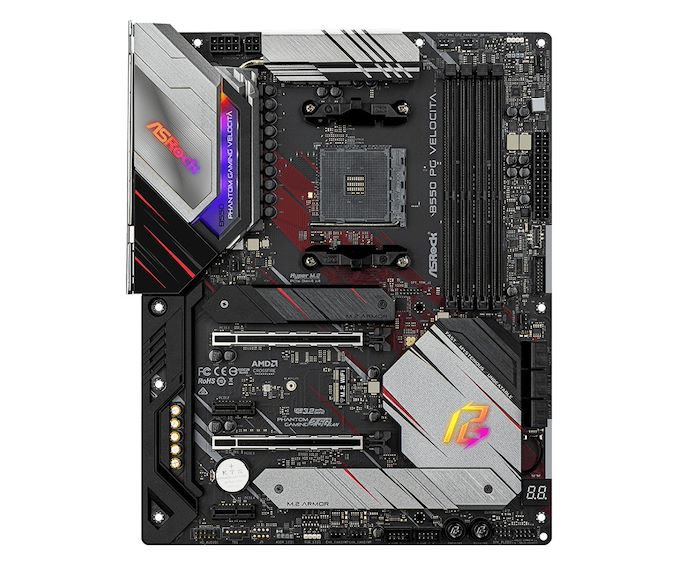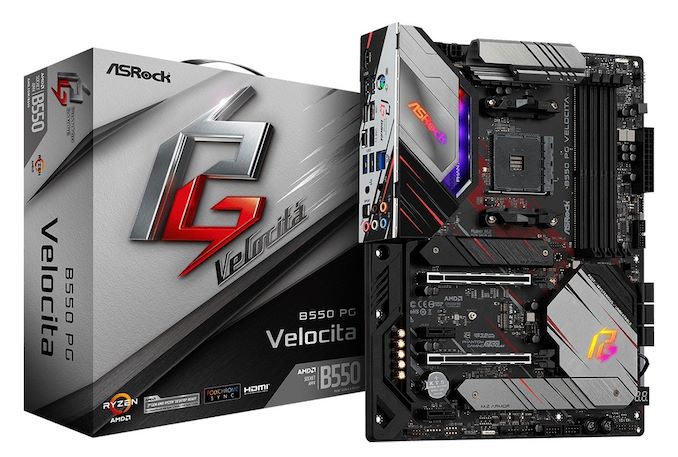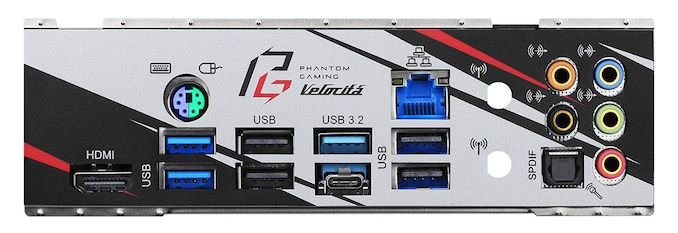The AMD B550 Motherboard Overview: ASUS, GIGABYTE, MSI, ASRock, and Others
by Dr. Ian Cutress & Gavin Bonshor on June 16, 2020 11:00 AM ESTASRock B550 PG Velocitá
The new Velocitá branding from ASRock, as started on Z490, is an attempt to define a high-end motherboard based on speed, but also style, hence the name ‘Velocitá’. In previous incarnations, ASRock motherboards would often show pictures of high performance sports cars that eerily looked very close to the popular Lamborghini of the day, but those boards were focused on overclocking. This time Velocitá is more about the gaming, hence it falls under the Phantom Gaming family.
The PG Velocitá is a relatively clean board to look at, with the main style focused on a 45-degree downward slope from left to right, and a number of jagged edges on decals around the motherboard. As we can see, there is also some element of RGB here, on the chipset heatsink and on top of the rear panel. There is also a pair of onboard RGB headers at different ends of the board.
The power delivery heatsinks in the Velocitá are connected via a heatpipe, hiding a 12+2 phase design indicative of which market ASRock wants to push this product. Powering the CPU is an 8-pin and a 4-pin, while the socket area has access to five 4-pin fan headers within easy reach.
Down the right side of the motherboard is a Type-C front header, a USB 3.0 front header, six SATA ports from the chipset, and a two digit debug. Along the bottom are more fan headers, two USB 2.0 headers, power/reset buttons, and a front panel connector.
For the PCIe layout, the top full-length slot is a PCIe 4.0 x16 slot from the CPU, while the second full-length slot is a PCIe 3.0 x4 from the chipset. Surprisingly both of these have additional reinforcement. There is also a PCIe 4.0 x4 M.2 slot above the top PCIe slot for the main M.2 drive, and ASRock puts another PCIe 3.0 x2 M.2 slot on the bottom of the motherboard, and this heatsink is connected to the chipset heatsink.
The audio on the right of the motherboard is an enhanced Realtek ALC1220 design, featuring an NE5532 amp.
The rear panel gives the user a HDMI port, a combination PS/2 port, two USB 3.2 Gen 1 ports, four USB 2.0 ports, a Type-A USB 3.2 Gen 2 port, a Type-C USB 3.2 Gen 2 port, a Realtek RTL8125BG 2.5 gigabit Ethernet port, space for an add-in Wi-Fi antenna output, and the audio jacks.













101 Comments
View All Comments
Operandi - Tuesday, June 16, 2020 - link
Looks like some nice mATX versions this round, nice!YB1064 - Thursday, June 18, 2020 - link
I was hoping to see a $75-$90 board.kenjiwing - Tuesday, June 16, 2020 - link
Fortunately, this component is a unique motherboard among B550 and well worth reading up on [add link].Needs to be edited.
anirudhs - Tuesday, June 16, 2020 - link
There's a noise sensor which can adjust fan speed for maximum quietness with good thermals. Saw it on the KitGuruTech video. The noise sensor isn't there to spy on you though.PeterCollier - Wednesday, June 17, 2020 - link
The quality of the editing here is shit tier. Seriously, just run the articles through Grammarly before publication. It's free and it spots plenty of errors.Heavenly71 - Tuesday, June 16, 2020 - link
Sadly none of the mITX boards have more than 6 external USB ports. My old ASUS mITX has 8! And in really small mITX cases you can't add a bracket with more USB, because the two brackets are already used by the gfx card. Guess I have to wait for an enthusiast mITX board )-:damianrobertjones - Tuesday, June 16, 2020 - link
Or, just maybe, get a usb dongle with 4 ports?Mr Perfect - Tuesday, June 16, 2020 - link
That is disappointing. The number of USB devices people need to plug in can't be dropping, surely? I know I've got more now then even a year ago.rrinker - Tuesday, June 16, 2020 - link
Are they really going up? I have 2 USB devices plugged in to my system - a keyboard and a mouse. I occasionally plug a USB stick in one of the front ports to transfer files. My phone and tablet sync over wifi, they don't get plugged in. I have a charger behind my desk and a cable to charge them. My printer is on the network.The one place I DO need lots of USB ports is also the place where I have a small cube case machine, with no discreete GPU, because it doesn;t need one. On that one I added a USB PCI card to get enough ports. In addition to the keyboard and mouse, that machine is on my workbench where it connects to several electronic test instruments and I have multiple cabled for programming microcontrollers. I also have a USB microscope for board inspection. And then I have 3 more USB devices connected for my other hobby that shares the bench. Plus a front port kept free for USB sticks.
So the use case I have for more USB has the PCI slots open to add expansion cards, the use case where I have a discrete GPU eating up the slot space doesn't need an excess of USB ports.
DigitalFreak - Tuesday, June 16, 2020 - link
I use 3 USB 3.0 ports just for my Oculus Rift